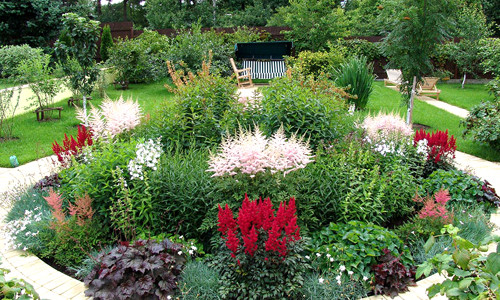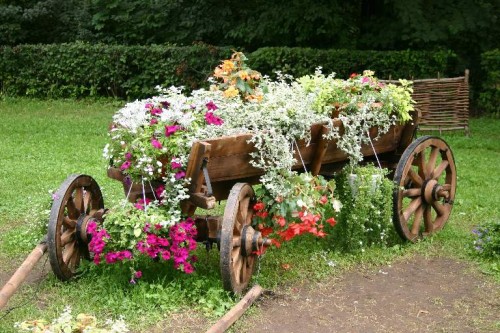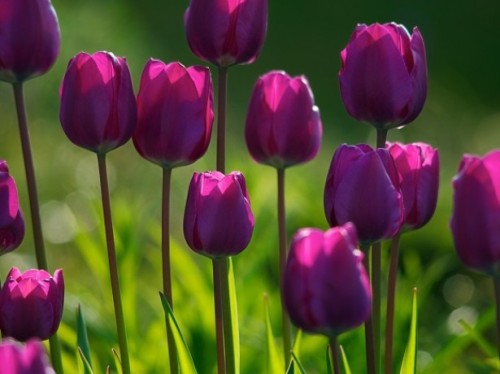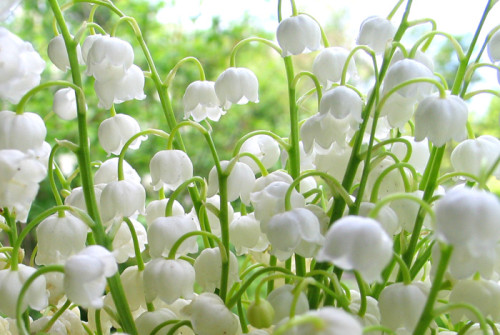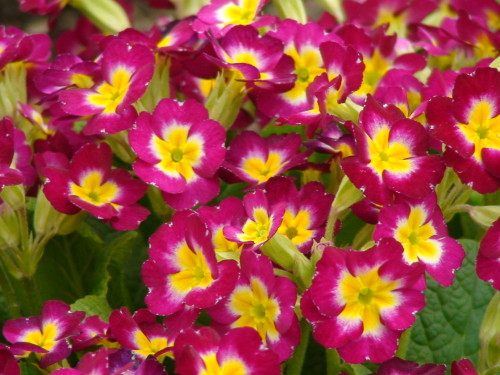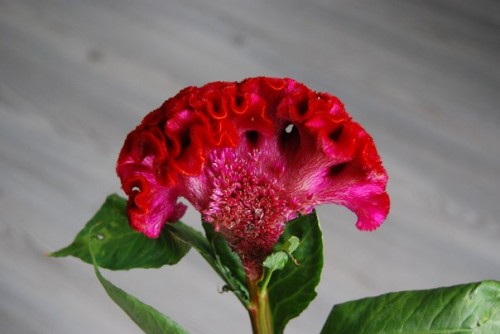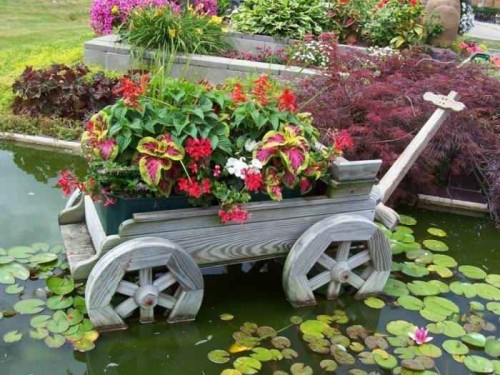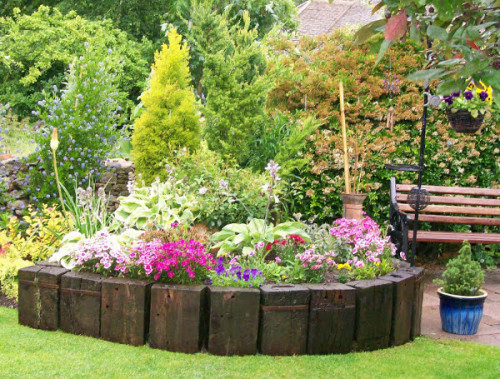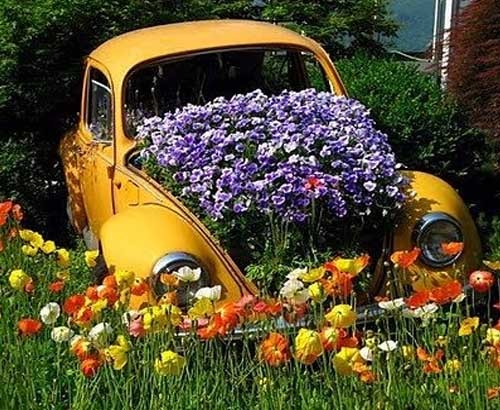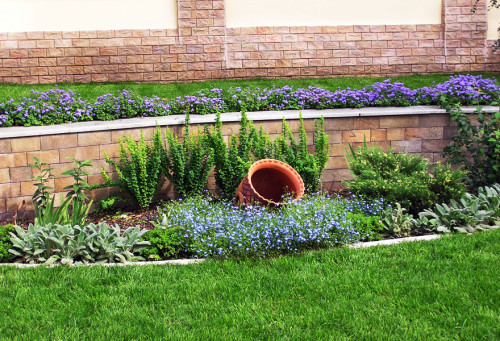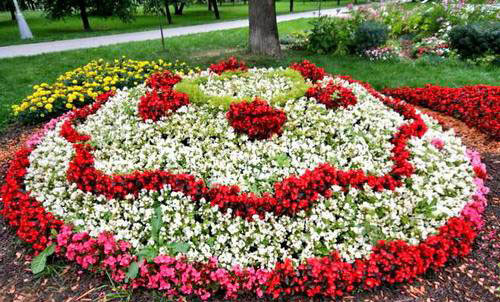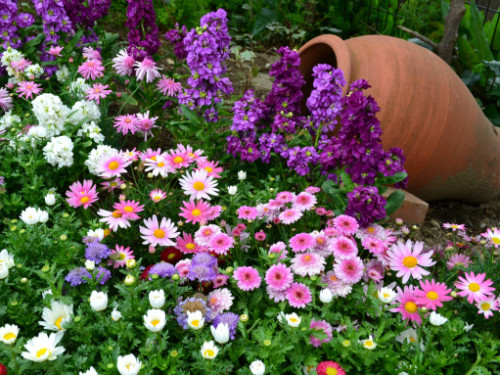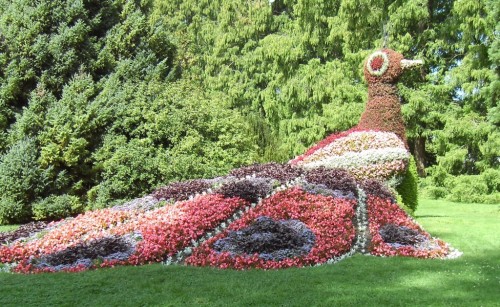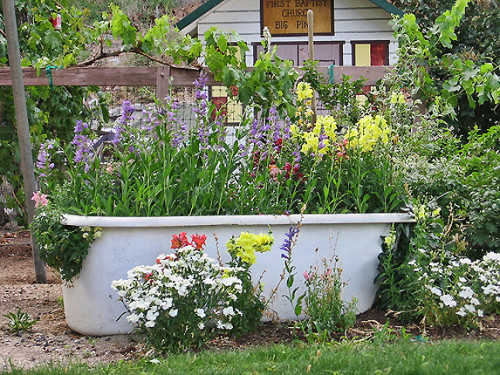The flower garden is a purely aesthetic phenomenon that does not bear almost no practical benefit, but is unusual popularity. Properly designed, he is able to instantly transform the exterior and set the “mood” of the entire landscape design of the site. In addition to decoration, the flower garden is necessary for a visual association of a residential building with garden vegetation. In this article you will find many secrets of professional landscape designers and learn how to make a flower garden design with your own hands.
Content
General rules for creating a flower garden
Flowers can become the main decoration of any garden or a small summer cottage, but they require special care, like any other cultivated plants. If small clusters of flowers are randomly scattered around the site, they will not bring great joy to the owners, but if you collect the same flowers together and combine into a neat composition, the result will be much more spectacular. To create a composition of flowers can do absolutely anyone, but if you know some rules, you can increase the aesthetics of the flower garden and simplify plant care in the future.
First of all, it is necessary to figure out which plants can be used to design flower beds and flower beds. In the photo below, you can see many different cultures, each of which has its own flowering period, size, color, etc.
The rules of landscape design will help you beautifully arrange a flower garden:
- Follow the integrity - imagine that you are an artist, and the garden is your canvas and you need to apply paints on it - various varieties of plants. The picture should be made up of several landscape compositions with a center in a flower garden. There is no point in thoughtlessly “throw” the plants around the site. Instead, break the entire area into several sectors, think about what will be “depicted” in each, then begin to create compositions, bringing each to perfection.
- Place the plants depending on their growth. The multi -tier placement principle helps not only save a useful area, but also create very spectacular compositions. In the foreground, place low -growing and creeping plants - they will perform the function of framing your future picture. But take the main roles with medium -sized lush -flowering cultures (preferably perennials). And to emphasize their beauty, place tall plants with decorative foliage or contrasting flowers in the background. Combinations in the color of buds and the shape of the leaves are also acceptable.
- Think over the architecture, taking into account the landscape features of the site, as well as its dimensions. Depending on these factors, the decoration of the flower garden in the country can be made in the form of a flat composition or slightly raised and framed by a decorative fence. We will talk about the varieties of fences at the end of the article. If you plan to break the flower garden right in front of the house, certainly first draw a detailed plan. It should include not only the geometry of plantings, but also varieties and features of plants used for design.
Many practically do not think, juggling with the terms “flowerbed” and “flower garden”, and by the way, these are completely different concepts. Of course, the essence remains the same - this is the place where the flowers grow, but the flowerbeds are mostly limited by the correct forms. Strict geometry reigns here, while the flower garden can be completely anything. Moreover, it may not even be located on the ground, but hang in the air or fit in an old cart. Photos of such a flower garden design is shown below:
Compositions from perennials
So, you decided to break the flower garden on the site and now you need to choose plants for its design. Conditionally, all of them can be divided into two large categories: perennials and annuals. The advantage of the first is that you do not have to plant new flowers every year, but only cut and form already rooted. However, if you like diversity, choose annuals - so every year you can create new original flower arrangements. In addition to the life expectancy, an important role is played by the flowering period: spring or summer. Knowing and skillfully managing this factor, you can make a flower garden that will delight with bright colors from April to September!
Blooming in the spring
The most “early birds” in the world of flowers are bulbous primroses and even though flowering period does not last long, bright juicy colors and delicate petals delight the eyes after a long cold winter. The very first snowdrops bloom, then they are replaced by crocuses and hyacinths, after which tulips and daffodils come. Tulips fade by mid -May, but at this time you can already enjoy the impermeable aroma of lily of the valley. Such an uninterrupted “parade” of spring flowering lasts until the summer.
To create a spectacular composition of primrose, place them in height and flowering period. So, tulips, hyacinths and daffodils can be planted in the center, and closer to the edges of the flower garden to arrange the rows or “islands” of the valley, snowdrops and crocus. You will find useful information in the article “Crocuses on the lawn. Landing and growing rules ". Different varieties of tulips, placed in the center of the round flower bed, look very beautiful. Yellow and white daffodils are in perfect harmony with any tulips.
So that plants can form the largest flowers, plant them at a short distance. Depending on the characteristics of the culture, make mineral and organic fertilizers, carry out regular watering.
Blooming in the summer
The delicate and modest flowering of the first spring plants over time intensifies and is gaining strength closer to the summer, becoming more magnificent, colorful and spectacular. Summer flowers are distinguished by some kind of pomp and a riot of colors, and therefore they look very beautiful on any flower garden. The primrose is the earliest summer -flowering plant of perennials. She will perfectly complement any composition, if you land it in the form of parallel borders. The primrose is perfectly combined with all kinds of violet varieties, pansies and daisies.
In the summer, the queen of all colors is dissolved by his buds - a rose. It looks great against the backdrop of high -growing shrubs with decorative leaves or in the neighborhood of phlox. If you have never engaged in growing roses before, an article will help you "Rosary in the country: breakdown schemes, arrangement tips, design options".
For a beautiful decoration of the flower garden, it is extremely important to carefully think over the design, to develop patterns of proper care of plants. It is necessary to carefully study the requirements of each culture used to soil, watering, climatic conditions so that there are no critical situations, for example, when one flower needs acidic soil, and its neighbor accepts only alkaline.
Compositions from annuals
If you like diversity and want to update your flower garden annually, replenishing it with new plant varieties, use it for the design of annuals. The main feature of such cultures is especially magnificent and colorful flowering. They can be understood - since nature has made them so that the plant can bloom only once in a lifetime, you need to make this flowering as beautiful as possible!
Such annual compositions are especially good for those who visit the cottage with raids and spending little time on it. Annials do not need regular and thorough care, and even if you forget to water them, nothing terrible will happen. You can make the design of flower beds with marigolds, begonias, dahlias, petunias, balsams, etc. The compositions with cells in the center look beautiful. These are completely unusual plants that are very common in urban flower beds. They are tall and immediately catch the eye with a bright al-raspberry color.
There are a number of unspoken rules that will help you make the decorative design of the flower garden for envy to all neighbors:
- Without exception, all the colors to one way or another need sunlight - without it they simply cannot dissolve the buds. During the period of intensive development, all the stems will rush to the sun, so if the flower garden is located in the northern part of the garden, it is best to fill it with marigolds, irises, zinnii and dolphinium. Other flowers will unfold to the sun, turning out of the "spectators".
- Maintain a certain distance between plantings so that the flowers do not crowd and prevent each other from developing. At first glance, it may seem that the plants are planted too far from each other, but this is only until they are covered with thick foliage and will truly grow. If you notice that the colors do not have enough free space, it is necessary to sake them.
- Consider the height used in the design of colors, planting them from the highest to the lowest. The relevant information can be viewed on the packaging with landing material.
- The faded plants of the annuals must be removed in a timely manner so that they do not take the useful substances from the soil and free up the place for other crops. The wilted buds of perennials should also be cut off immediately so that they do not spoil the appearance. In addition, such a procedure can provoke re -flowering of the plant.
- Plant plants with different flowering periods in one flower garden, stretching them as much as possible. Here you can "play" not only directly to flowering dates, for example, April-May, but also the time of day. So, some flowers are opened in the morning and day, and some - in the evening and at night. One of the most unpretentious "night" flowers is the imopey.
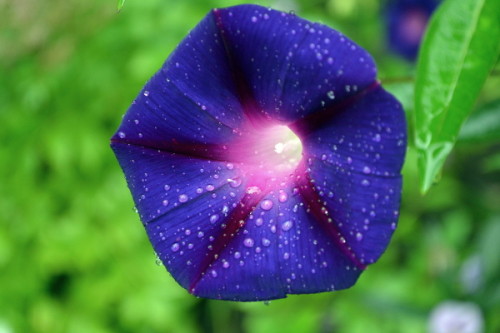
The night gladiolus also looks very beautiful:
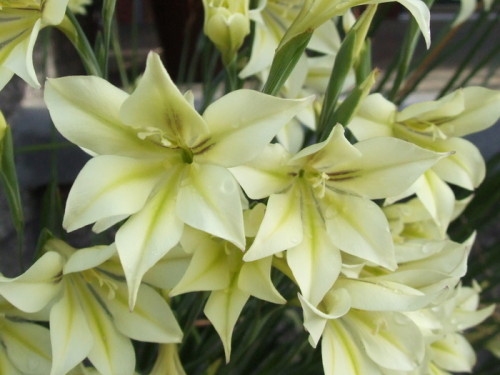
Lilia Casablanca spreads closer to the evening, accompanying a spectacular spectacle with a thin aroma for which perfumers especially appreciate it:
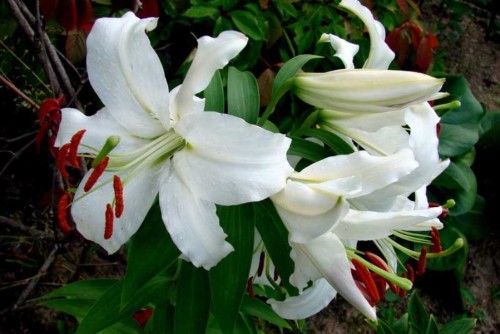
Even if you think that the design of a small flower garden requires artistic talent and skills of a professional landscape designer, we hasten to please you - everything is not entirely true. In fact, you just need to competently put up plants according to the above rules, and as a reward for the efforts you will receive magnificent and prolonged flowering. In the future, you can "play" the colors of buds and varieties of colors, and at first you can simply learn to create compositions correctly.
Fence design
Mindful that the garden is a picture with a clearly thought out composition and color flowers, it is necessary to take care of a decent framing. As a frame, we suggest using various types of decorative fences for flower beds and flower beds. And like any true lady is able to make a scandal, hat and salad out of nothing, so a real virtuoso gardener will be made for arranging a flower garden. And in this case, indeed, literally anything, starting from broken bricks and stones, ending with unnecessary household utensils and broken furniture.
In any case, the fence is necessary in order to give the flower garden a complete neat appearance. The simplest, but rather costly option is a special fence that can be purchased at any flower store. However, if you strive for originality and would like to save extra money, read on.
What improvised materials can be used to create an original and beautiful fence for a flower garden:
- Wood is a natural natural material that will give the flower garden naturalness. It is a good heat insulator, heated quickly and is not able to freeze too much, so flower beds with a wooden fence in winter will freeze much less. One of the most successful examples of a wooden fence is Tyn or Blade. About what it is, read in the article "Do -it -yourself wattle".
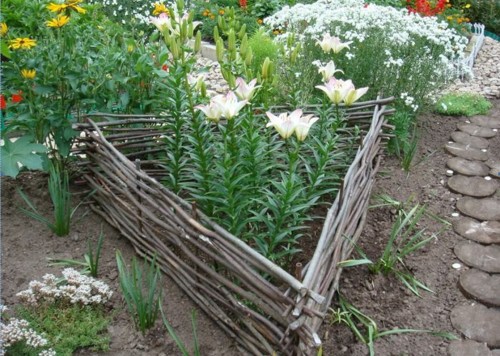
- The stone and brick - this “good” will be found with excess on any site, and if not, then you can get suitable stones without any difficulty. The fence laid out of boulders turned out to be especially beautiful, and if the garden paths are made of pebbles, the price will not be such a garden! The main advantage of the decoration of the flower garden is reliability and durability.
- The bottles - bottle fences are a real embodiment of the celebration of the artistic thought of the modern gardener. Such a seemingly useless and familiar material, like a glass bottle can serve excellent service, becoming a neat framing of the flower garden. By the way, glass bottles on the site can be used to create garden paths, insulation of walls, floor and even build a new house! The same can be said about plastic bottles, but their service life is much less, and the aesthetics leaves much to be desired. To make a fence made of glass bottles, fill them with half sand and dug in the ground with the necks down.
Remember that the flower garden, unlike the flowerbed, is not tied to any geometric forms or areas, so it can be broken literally anywhere. If you have an old piano in your barn, which no one wants to pick up, but not rising a hand, make a flower garden out of it! The same applies to any old furniture, carts, shells, baths and other unnecessary nonsense, which only occupies free space. Show a little imagination and create your unique landscape design.

